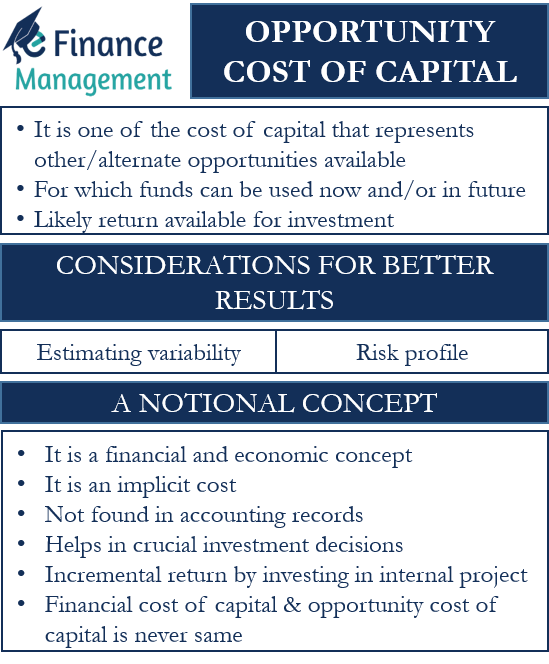A financial cost of capital, in simple words, is the average cost of financing the current projects. And this cost of capital is always represented in percentage terms. In other words, the total financing cost divided by all the investments is the cost of capital for any entity. In contrast, the opportunity cost of capital represents the other or alternate opportunities available for which the funds can be used now and/or in the future. Hence, the opportunity cost is the likely return that will be available to the entity by investing in those alternate opportunities.
Opportunity Cost – A Notional Concept
The opportunity cost of capital is a financial and economic concept. However, this is not an explicit cost that a company needs to incur. Nor does this find any place in the accounting records of the entity. Instead, it is an implicit or notional cost that helps management make crucial investment decisions. Or helps management in deciding between various available alternatives.
Talking about the definition, the opportunity cost of capital is the incremental return that one foregoes by investing the capital in an internal project rather than investing it in a marketable security. One can easily calculate the opportunity cost of capital by subtracting the returns of the alternative projects.
Usually, the financial cost of capital and the opportunity cost of capital is never the same. However, if the project that the company is considering is the only possible project and it is not comparable with any other projects, as well as other projects are well funded. Then only the two costs of capital can be equal. Simply stated, there is no alternate opportunity available for investing those funds. Hence, no comparison is possible, and there exists no opportunity cost.
Also Read: Cost of Capital
Example of Opportunity Cost of Capital
Generally, a company should not invest in an internal project if its estimated return is less than the expected return on the marketable security. Or investment in non-risky security. So for comparison’s sake, the return on non-risky investments becomes the benchmark or minimum rate of return. And therefore, one should not invest where the returns are not higher than the minimum or reference rate.
For example, the management of a company is considering two options to invest $1 million of its surplus funds. The first option is to establish a new manufacturing facility, which could give a long-term return of 8%. And the second option is to invest $1 million in stocks which could provide a long-term return of 12%.
On the basis of the opportunity costs concept, it is better for the company to invest funds in stocks. In this case, the opportunity cost of capital for the company would be 4%. This is considering the risk associated with both types of investments is almost the same. So the interpretation would be that if the company makes investments in the project, then it will lose a 4% return on those invested funds.

Opportunity Cost of Capital – Considerations to Get Better Results
The concept of the opportunity cost of capital may look simple, but in reality, one needs to consider a lot of things for its calculation. One major consideration is estimating the variability in the returns on the other investment over the period.
Also Read: Factors Affecting Cost of Capital
For instance, in the above example of stock and manufacturing facility, management’s estimate of the return from the manufacturing facility is more likely to be accurate than its estimate of the stock market returns. In fact, there are good possibilities that the stock return could be negative over the set period.
Thus, it is crucial that the estimate includes the variability of the return. Hence, the estimation should use the probability parameters to include the variability in the calculation. As well as to bring at par the returns on various alternate opportunities available. And then use the weighted average to come up with the most likely return.
Another consideration is the risk profile. The concept of the opportunity cost of capital will give the best results if we use it to compare projects sharing similar risk profiles. Selecting similar projects would help to take away the bias when evaluating the projects.
Example
Let us try to understand this with respect to investing in government bonds and stock market securities. Generally, the stock market would always give more return than government bonds. So, when comparing the two, the stock market will always be the best choice. However, these two investments have a very different risk profiles.
The govt. bonds are less risky as well as offer a guarantee of return. At the same time, the stock investment is undoubtedly riskier. And there remains no guarantee of return that can fluctuate both ways (negative and positive). Thus, using a less risky project as the opportunity cost of capital would always result in a bias towards the riskier option.
This is why it is important to use projects with the same risk profile.
Final Words
The opportunity cost of capital is a very important financial concept that helps management to decide on the best use of the funds. However, one must never forget that there could be a lot of variability between the estimate and the actual return. Thus, it becomes crucial to consider all factors when determining the opportunity cost of capital, including the risk profile of the projects. The use of probability analysis will be quite helpful in correcting the over-optimistic or over-pessimistic projections.

